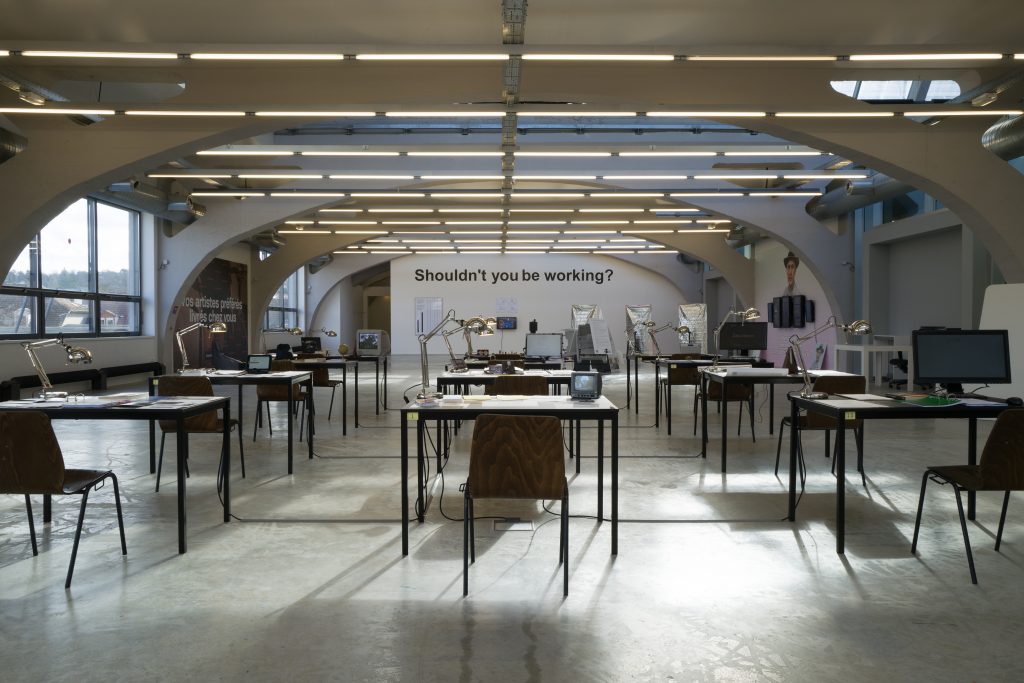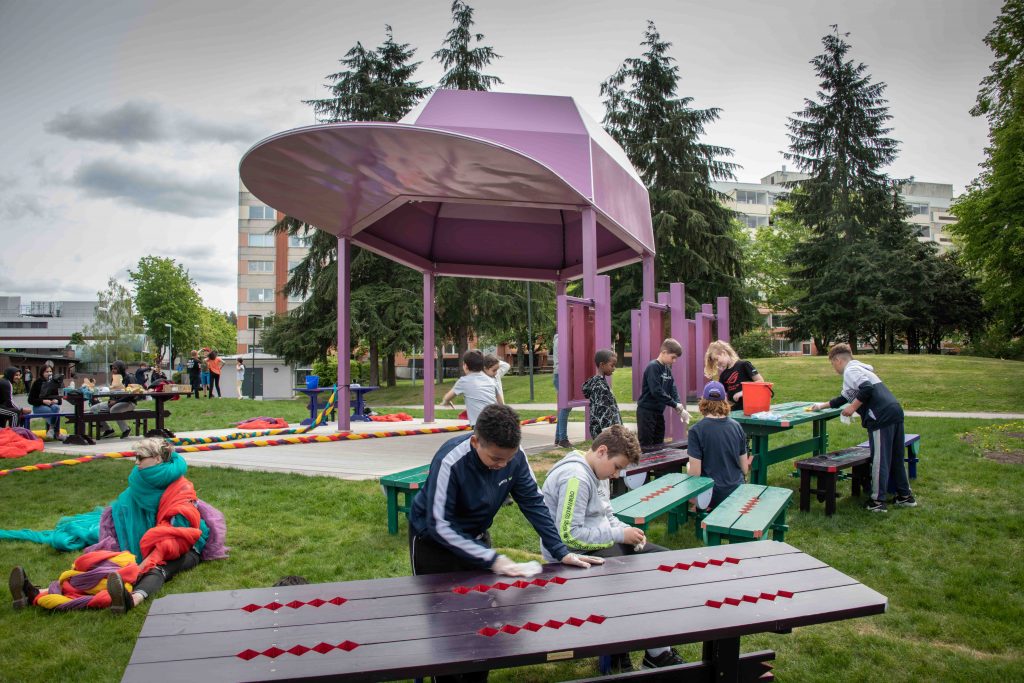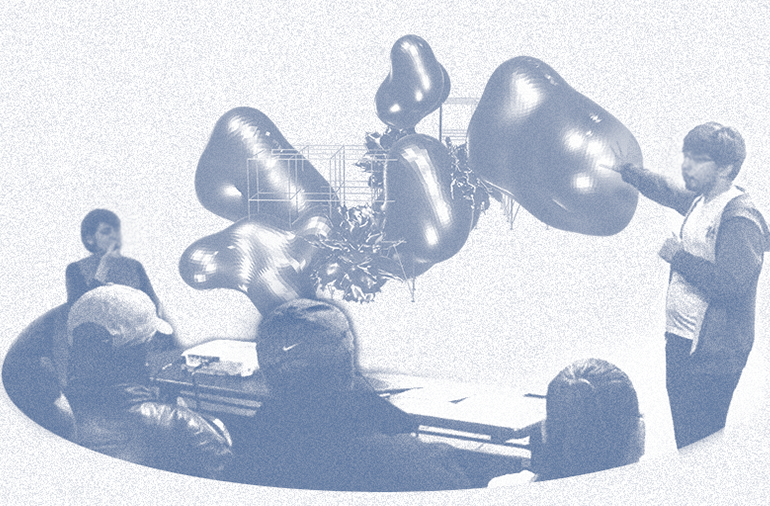Välkommen till det fjärde seminariet i serien Vulnerability by Design – om etiska och politiska aspekter av socialt engagerad design, gränser, kroppar och miljöer.
I detta seminarium kommer våra gäster att diskutera hur kroppsliga sårbarheter bildas genom intersektionella maktmatriser som formas av olika designmetoder från arkitektonisk och rumslig gestaltning till algoritmer, koder och data som riktar in sig på och exponerar vissa kroppar. Vem och på vilka villkor kan, i ett sådant tillstånd, utforma en värld mot mer rättvisa samhällen, när design och dess grund är en del av att förstärka kroppsliga sårbarheter som formas av kön, klass och ras? Medverkande: Mariana Alves, Lilly Irani och Silvio Lorusso, introduktion och moderering av Mahmoud Keshavarz (Lilly Irani medverkar online).

Shouldn’t You Be Working? by Silvio Lorusso at Kunsthalle Mulhouse, 2020. Foto: Sébastien Bozon
Vulnerability by Design utforskar förhållandet mellan design och olika former av sårbarhet eller utsatthet kopplade till människa, djur och miljö. Design som socialt engagerad praktik engagerar sig i olika sammanhang men riskerar att även bidra till nya former av utsatthet. Vilka metoder och kunskaper behövs för att identifiera etiska och politiska aspekter av detta engagemang kopplat till olika förutsättningar och situationer? I en serie seminarium med olika fokus; gränser (Borders), kroppar (Bodies) och miljö (Environments), belysas och diskuteras detta med inbjudna svenska och internationella gäster.
Under det senaste decenniet har det skett en spridning av designmetoder som engagerar sig i frågor om sårbarhet och utsatthet kopplad till olika individer, grupper och varelser, från människor till djur och miljöer. Dessa metoder syftar ofta till att övervinna eller motverka utsatthet i dessa olika sammanhang. Här förlitar man sig ofta på designens centrala förmåga att spekulera, föreställa sig eller förutse möjliga relationer, arrangemang och konfigurationer mellan befintliga situationer och möjliga framtider. I dessa processer finns det dock många antaganden och oklarheter kring vad en utsatt situation är och om den kräver ett ingripande genom design. Vem och under vilka förhållanden kan hävda en mindre utsatt position där man kan närma sig en mera utsatt sådan och som man tycker är i behov av en designlösning? Är design bara ett verktyg, separerat från detta utsatta sammanhang som det ämnar ta sig an? Finns det en risk att designen skapar nya former av utsatthet genom att engagera sig i dessa sammanhang? Hur kan materialitet, partiskhet och begränsningar inom designen dessutom bidra till ytterligare utsatthet?
Vulnerability by Design är en serie publika evenemang på IASPIS med fokus på att kritiskt belysa och diskutera hur socialt engagerad praktik inom design och arkitektur kan engagera sig i brännande samhällsfrågor. Vulnerability by Design utvecklas av IASPIS, Konstnärsnämndens internationella program för bild och form, med Magnus Ericson, programansvarig form, i samarbete med Mahmoud Keshavarz, lektor i Design Studies på Göteborgs universitet och forskare vid Engaging Vulnerability på Institutionen för kulturantropologi och etnologi, Uppsala universitet.
Läs mer om seminariet och de medverkande nedan (på engelska).
English
Vulnerability by Design: Bodies, intersectional vulnerabilities
Date: Tuesday 25 October 2022
Time: 5 – 7.30 PM
Place: IASPIS/Konstnärsnämnden and online (see link below)
Address: Maria skolgata 83, Stockholm
Language: English
Free admission, no reservation needed
Welcome to the fourth in the Vulnerability by Design series of public seminars on the ethics and politics of design engagement across borders, bodies and environments, with Mariana Alves, Lilly Irani and Silvio Lorusso, introduction and moderation by Mahmoud Keshavarz (Lilly Irani will participate online).
In this seminar, our guests will discuss how bodily vulnerabilities are formed through intersectional matrixes of power that are shaped by different practices of designing from architectural and spatial configuration to algorithms of codes and data targeting and exposing certain bodies. In such condition, who and on what terms can design a world towards more just societies, when designing and its foundation is part and parcel of reinforcing bodily vulnerabilities shaped by gender, class and race?

Kepsen in Råslätt by MYCKET, 2020. Photo: Ricard Estay
Vulnerability by Design explores the intersections of what forms of human, animal and environmental vulnerabilities are engaged, resisted and/or produced by design and designing, and how the vulnerability, partiality and limits of design and designing are exposed through various tactics and techniques. It poses an urgent question: what methodologies and knowledge are required to recognize the ethics and politics of design engagement with our and others’ vulnerable conditions? Through three main themes of borders, bodies and environments, these questions and concerns will be highlighted and discussed in a series of seminars with Swedish and international guests.
In the recent decade there has been a proliferation of design practices that engage with the vulnerability of different individuals, groups and beings from humans to animals and environments. These design practices often aim to overcome or resist the vulnerable conditions in which they intervene. In doing so, they often rely on one of the main capacities of designing, in speculating, imagining or envisioning possible relations, arrangements and configurations between existing situations and possible futures.
In these processes, however, there are many assumptions and ambiguities around what constitutes a status as vulnerable which calls for a designerly intervention. Who claims the less vulnerable position from which others can be approached as more vulnerable and in need of a better design; and under what conditions? Is design merely a tool separated from the conditions of vulnerability, which it seeks to address? Is there a risk that through engaging with such conditions, the act of designing would generate other vulnerabilities often not recognized by the designers? Furthermore, how does materiality, partiality and limits of designing make design also vulnerable in its own way?

Just Transitions Initiative. Illustration: Sophia Lee, photo: Mikaiil Hussain
Vulnerability by Design is part of a public events programme at Iaspis, critically looking at how socially engaged practices within design, craft and architecture may engage with urgent societal issues. The programme has unfolded through various themes and formats from the autumn 2019. Vulnerability by Design is developed by IASPIS through Magnus Ericson, Head of Applied Arts at IASPIS with Mahmoud Keshavarz, Associate Professor in Design Studies, University of Gothenburg and Researcher at the Engaging Vulnerability Programme, the Department of Cultural Anthropology and Ethnology, Uppsala University.
Mariana Alves Silva is a designer and artistic researcher working in different ways with reparative spaces and spaces of sharing and learning. Mariana is one of the co-founders of the design- architecture- and art collective MYCKET together with architects and artists Katarina Bonnevier and Thérèse Kristiansson. Together they develop methods to critique and construct at once. They have generated a broad range of outcomes such as exhibitions, permanent public spaces, large-scale theatrical productions, and text- and theory production. Alongside their work Mariana has also been teaching design theory, conducted research on design methodology, and made exhibitions, visual communication, set design, and other handicrafty outcomes.
Lilly Irani is an Associate Professor of Communication & Science Studies at University of California, San Diego where she co-directs the Just Transitions Initiative. She also serves as faculty in the Design Lab, Institute for Practical Ethics, the program in Critical Gender Studies. She is author of Chasing Innovation: Making Entrepreneurial Citizens in Modern India (Princeton University Press, 2019) and Redacted (with Jesse Marx) (Taller California, 2021). Chasing Innovation has been awarded the 2020 International Communication Association Outstanding Book Award and the 2019 Diana Forsythe Prize for feminist anthropological research on work, science, or technology, including biomedicine. Her research examines the cultural politics of high-tech work and the counter-practices they generate, as both an ethnographer, a designer, and a former technology worker. She is a co-founder of the digital worker advocacy organization Turkopticon.
Silvio Lorusso is a writer, artist and designer based in Rotterdam, the Netherlands. His work focuses on the cultures and rhetorical regimes embedded in techno-social systems. His practice combines various media such as video, website, artist’s book, installation, lecture. This activity is further stimulated by writing essays, curating exhibitions and organizing public programs. In 2018 he published his first book entitled Entreprecariat (Onomatopee, English; Krisis, Italian). Silvio Lorusso is an assistant professor at the Centre for Other Worlds of the Lusófona University in Lisbon, a creative coding tutor at the Royal Academy of Art in Den Haag and a lecturer at the Design Department of the Sandberg Institute. He is a member of Varia, the Center for Everyday Technology, as well as part of the editorial board of Italian graphic design magazine Progetto Grafico. Silvio Lorusso holds a Ph.D. in Design Sciences from the Iuav University of Venice.
